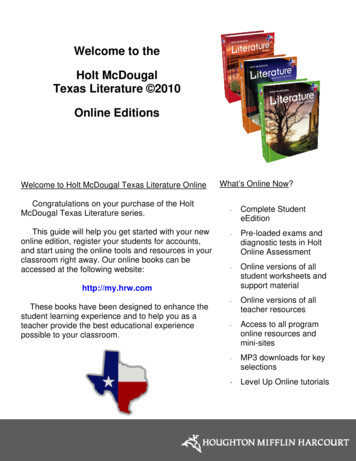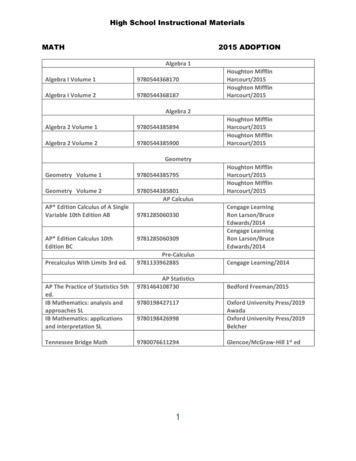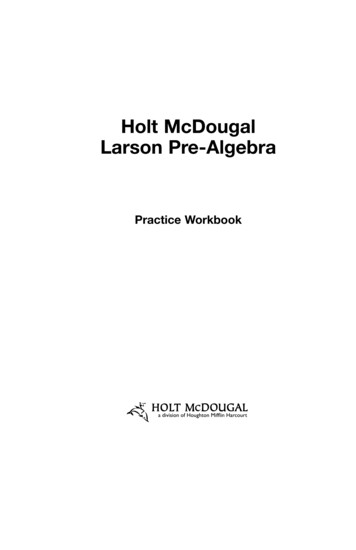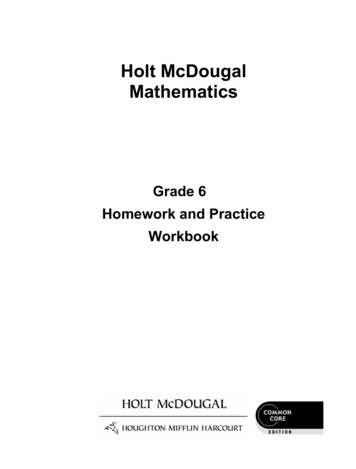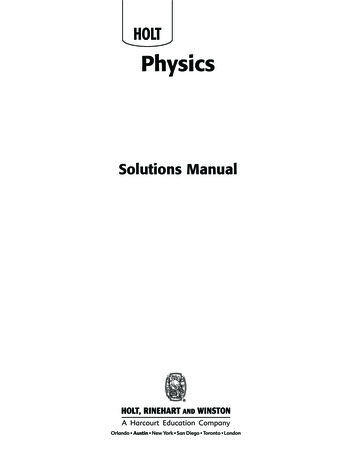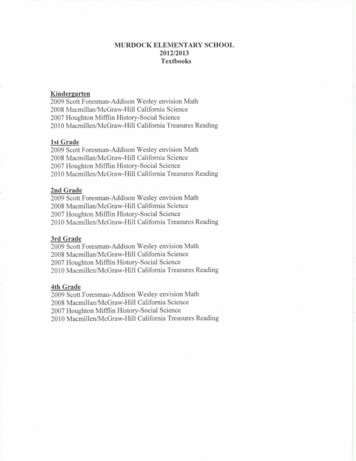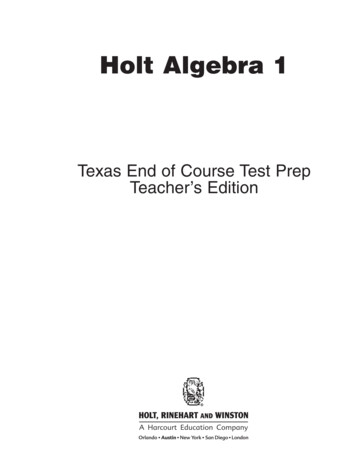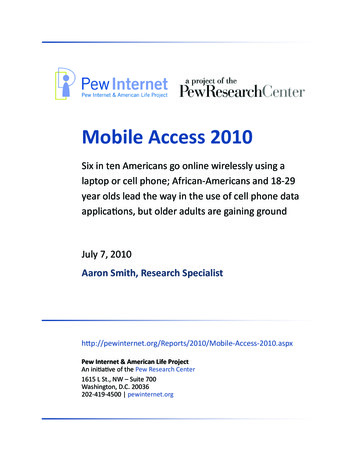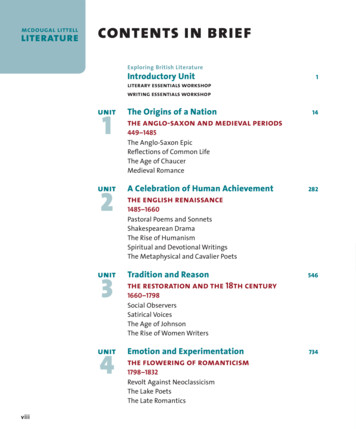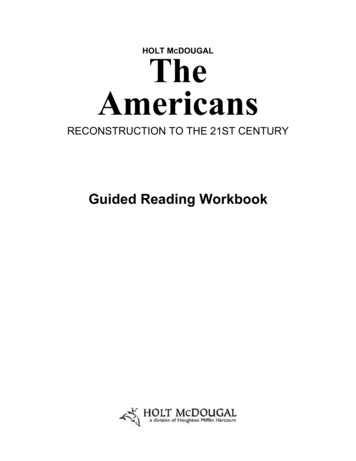
Transcription
HOLT MCDOUGALTheAmericansRECONSTRUCTION TO THE 21ST CENTURYGuided Reading Workbook
Copyright by Houghton Mifflin Harcourt Publishing CompanyAll rights reserved. No part of this work may be reproduced or transmitted in any form or byany means, electronic or mechanical, including photocopying or recording, or by anyinformation storage or retrieval system, without the prior written permission of the copyrightowner unless such copying is expressly permitted by federal copyright law.Permission is hereby granted to individuals using the corresponding student’s textbook or kitas the major vehicle for regular classroom instruction to photocopy entire pages from thispublication in classroom quantities for instructional use and not for resale. Requests forinformation on other matters regarding duplication of this work should be addressed toHoughton Mifflin Harcourt Publishing Company, Attn: Contracts, Copyrights, and Licensing,9400 South Park Center Loop, Orlando, Florida 32819.Printed in the U.S.A.ISBN 978-0-547-52136-7123456789XXX16 15 14 13 12 11 10450000000000 A B C D E F GIf you have received these materials as examination copies free of charge, HoughtonMifflin Harcourt Publishing Company retains title to the materials and they may not beresold. Resale of examination copies is strictly prohibited.Possession of this publication in print format does not entitle users to convert thispublication, or any portion of it, into electronic format.
ContentsBeing a Strategic Reader . vChapter 1 Exploration and theColonial EraSection 1. 1Section 2. 5Section 3. 9Section 4. 13Chapter 8 Life at the Turn of the20th CenturySection 1 . 108Section 2 . 111Section 3 . 114Section 4 . 118Chapter 2 Revolution and the EarlyRepublicSection 1. 17Section 2. 21Section 3. 24Section 4. 28Chapter 9 The Progressive EraSection 1 . 122Section 2 . 126Section 3 . 129Section 4 . 133Section 5 . 136The Living ConstitutionSection 1. 31Section 2. 35Section 3. 39Section 4. 42Chapter 10 America Claims anEmpireSection 1 . 140Section 2 . 143Section 3 . 147Section 4 . 151Chapter 3 The Growth of a YoungNationSection 1. 46Section 2. 49Section 3. 53Section 4. 56Section 5. 59Chapter 11 The First World WarSection 1 . 155Section 2 . 159Section 3 . 163Section 4 . 167Chapter 12 Politics of the RoaringTwentiesSection 1 . 171Section 2 . 175Section 3 . 178Chapter 4 The Union in PerilSection 1. 62Section 2. 66Section 3. 70Section 4. 73Chapter 13 The Roaring Life of the1920sSection 1 . 181Section 2 . 185Section 3 . 188Section 4 . 191Chapter 5 Changes on the WesternFrontierSection 1. 77Section 2. 81Section 3. 84Chapter 6 A New Industrial AgeSection 1. 88Section 2. 91Section 3. 94Chapter 14 The Great DepressionBeginsSection 1 . 194Section 2 . 198Section 3 . 202Chapter 7 Immigrants andUrbanizationSection 1. 98Section 2. 101Section 3. 104Original content Houghton Mifflin Harcourt Publishing Company. Additions and changes to the original content are the responsibility of the instructor.iiiGuided Reading Workbook
ContentscontinuedChapter 15 The New DealSection 1. 205Section 2. 209Section 3. 212Section 4. 216Section 5. 219Chapter 21 Civil RightsSection 1 . 293Section 2 . 297Section 3 . 301Chapter 22 The Vietnam War YearsSection 1 . 305Section 2 . 309Section 3 . 312Section 4 . 315Section 5 . 319Chapter 16 World War LoomsSection 1. 222Section 2. 226Section 3. 230Section 4. 234Chapter 23 An Era of Social ChangeSection 1 . 323Section 2 . 327Section 3 . 330Chapter 17 The United States inWorld War IISection 1. 238Section 2. 241Section 3. 245Section 4. 249Chapter 24 An Age of LimitsSection 1 . 333Section 2 . 337Section 3 . 341Section 4 . 345Chapter 18 Cold War ConflictsSection 1. 252Section 2. 256Section 3. 259Section 4. 263Chapter 25 The Conservative TideSection 1 . 348Section 2 . 351Section 3 . 355Section 4 . 359Chapter 19 The Postwar BoomSection 1. 267Section 2. 271Section 3. 275Section 4. 279Chapter 26 The United States inToday’s WorldSection 1 . 363Section 2 . 367Section 3 . 370Section 4 . 373Chapter 20 The New Frontier and theGreat SocietySection 1. 282Section 2. 286Section 3. 289Original content Houghton Mifflin Harcourt Publishing Company. Additions and changes to the original content are the responsibility of the instructor.ivGuided Reading Workbook
Being a Strategic ReaderHow to Use This BookThe purpose of this Guided Reading Workbook is to help you read andunderstand your history textbook, The Americans: Reconstruction to the21st Century. You can use this Guided Reading Workbook in two ways.1. Use the Guided Reading Workbookside-by-side with your history book.Strategy: Read the Termsand Names and the definitionof each. The Terms andNames are in dark type in thesection. Turn to the section that youare going to read in thetextbook. Then, next tothe book, put the pagesfrom the Guided ReadingWorkbook that accompanythat section. All of theheads in the GuidedReading Workbook matchthe heads in the textbook. Use the Guided ReadingWorkbook to help youread and organize theinformation in thetextbook.2. Use the Guided ReadingWorkbook to study thematerial that will appearin the chapter tests. Reread the summary ofevery chapter. Review the definitions ofthe Terms and Names inthe Guided ReadingWorkbook. Review the graphicorganizer that youcreated as you readthe summaries. Review your answersto questions.Strategy: Use a graphicorganizer to help youorganize information in thesection.Strategy: Read thesummary. It contains themain ideas and the keyinformation under the head.Original content Houghton Mifflin Harcourt Publishing Company. Additions and changes to the original content are the responsibility of the instructor.vGuided Reading Workbook
Being a Strategic ReadercontinuedStrategy: Underline the mainideas and key information asyou read.Strategy: Answer thequestion at the end of eachpart.Original content Houghton Mifflin Harcourt Publishing Company. Additions and changes to the original content are the responsibility of the instructor.viGuided Reading Workbook
Being a Strategic ReadercontinuedThe last page of each section of the Guided Reading Workbook ends with agraphic organizer that will help you better understand the information inthe section. Use the graphic organizer to take notes as you read. The notescan help you to prepare for the section quiz and chapter tests.Original content Houghton Mifflin Harcourt Publishing Company. Additions and changes to the original content are the responsibility of the instructor.viiGuided Reading Workbook
Name Class DateExploration and the Colonial EraSection 1The Americas, West Africa, andEuropeTerms and Namesnomadic Moving from place to place in search of food and waterAztecs People who built an empire in Mexico, beginning in the 1200sAnasazi Native Americans of the Southwest, about A.D. 100 to 1300Pueblo Native American group in the SouthwestIroquois Native American group in Eastern North AmericaBenin African kingdom around the Niger River known for metalworkingKongo Small kingdoms on the lower Congo River united under one rulerIslam Religion founded by Muhammad in the 600sChristianity A religion based on the life and teachings of JesusReformation Split in the Christian Church that led to ProtestantismRenaissance A term meaning “rebirth” of the kind of interest in the physical worldthat had characterized ancient Greece and RomeBefore You ReadIn this section, you will learn about the people who lived in NorthAmerica, West Africa, and Europe in the 1400s. In the next section, youwill see how these people came together in the Americas.As You ReadUse a web diagram to take notes on how trade and commerce affectedregions in different time periods.ANCIENT CULTURES IN THEAMERICAS (Pages 4-6)Who lived in the Americas first?The first humans came to the Americasfrom Asia about 22,000 years ago. Overthousands of years, these nomadic peoplemoved from place to place, spreading outacross North and South America. Theylived by hunting animals and gatheringwild plants.Between 10,000 and 5,000 years ago(800 to 3000 B.C.), people living inMexico discovered a new way to get food.They began to raise plants or to farm. Thepractice of farming spread. Becausepeople who farmed no longer had tosearch for plant foods, they could stay inone place. They could turn their attentionto learning crafts and to building settledcommunities. In this way, farming madepossible the growth of civilizations.Beginning about 3,000 years ago (1000B.C.), a number of rich and complex NativeAmerican civilizations developed. TheOriginal content Houghton Mifflin Harcourt Publishing Company. Additions and changes to the original content are the responsibility of the instructor.1Guided Reading Workbook
Name Class DateSection 1, continuedWEST AFRICAN SOCIETIES OFTHE 1400S (Pages 8-10)What was life like in a West Africankingdom?Three powerful kingdoms with strongrulers played important roles in WestAfrica. Songhai controlled trade acrossthe Sahara Desert. Benin was a powerfulnation in the forests of the southerncoast. In central Africa, the kingdom ofthe Kongo united smaller areas underone ruler.Most West Africans lived with theirfamilies in small villages. They farmed,herded, hunted, and fished. The oldestpeople in the family had the mostinfluence over the others.Religious rituals were important indaily life. West Africans respected thespirits of living and non-living things.Many also believed in a single Creator.By the 1400s, some West Africanleaders had accepted a new religion calledIslam. Islam was founded by Muhammadin Arabia in 622. It taught that there isonly one God, called Allah. Islam laterspread among ordinary people.The kingdoms of West Africa wereconnected to North Africa, Europe, andAsia by trade. Sailors and traders arrivedfrom Portugal in the 1400s. SomePortuguese settled on islands off Africa.They started large farms, or plantations, togrow sugar cane. The Portuguese startedthe use of African slaves for field labor.Aztecs settled in Mexico in the 1200s. TheAnasazi farmed the dry areas of theSouthwest between 300 B.C. and A.D. 1400.1. Who were the first people to live inthe Americas?NATIVE AMERICAN SOCIETIES OFTHE 1400S (Pages 6-8)How did Native Americans live?Native American people lived in manykinds of environments. For example, thePueblo people lived in the drySouthwest (today’s Arizona and NewMexico). They built adobe houses andgrew corn and beans. In the forests ofthe Northeast (today’s New York state),the Iroquois hunted, fished, andgathered fruits and nuts.Trade routes across North Americalinked Native American groups that livedfar apart. Trade allowed them to shareboth goods and ideas.Native Americans did not buy and sellland. They treated the land as a resourcefor all groups to share. They felt that theworld was filled with spirits. For instance,the spirit of a relative who had died mightstill serve as a guide to the living.The family was the basic unit. Groupsof families, or clans, got together forspecial events. By the time Europeansarrived in North America, NativeAmerican cultures were thousands ofyears old.3. What were two ways of earning aliving in a West African kingdom?2. How did Native American people indifferent environments get their food?Original content Houghton Mifflin Harcourt Publishing Company. Additions and changes to the original content are the responsibility of the instructor.2Guided Reading Workbook
Name Class DateSection 1, continuedEUROPEAN SOCIETIES OF THE1400S (Pages 10-13)What was happening in Europe?In European societies, everyone had arank or position. Rulers and nobles ownedthe most land and were the most powerful.Leaders of the church, or clergy, were alsoimportant. At the bottom were thepeasants, who worked in the fields. MostEuropeans lived in small farming villages.European society was beginning tochange. Christianity, a religion based onthe life and teachings of Jesus, was thedominant religion in Western Europe. Inthe early 1500s, reformers called forchanges in the Church. Some of thesereformers broke away from the RomanCatholic Church and formed Protestantchurches. This movement was called theReformation.The Reformation led to a split inEurope between Catholics and Protestants.In this time four powerful nations arose:Portugal, Spain, France, and England.The 1400s were the time of theRenaissance, a term meaning “rebirth” ofthe kind of interest in the physical worldcharacterized by ancient Greece andRome. The new learning led to inventionslike the printing press and new ways tonavigate with new sailing technology.4. What were two important changes inEurope?Original content Houghton Mifflin Harcourt Publishing Company. Additions and changes to the original content are the responsibility of the instructor.3Guided Reading Workbook
Name Class DateSection 1, continuedAs you read about the cultures of the Americas, Africa, and Europe, fill outthe chart below by writing notes that describe the achievements of thosecultures.Achievements1. Ancient Americans2. Native Americans3. West Africans4. EuropeansOriginal content Houghton Mifflin Harcourt Publishing Company. Additions and changes to the original content are the responsibility of the instructor.4Guided Reading Workbook
Name Class DateExploration and the Colonial EraSection 2Spanish North AmericaTerms and NamesChristopher Columbus Italian explorer who sailed to North America for SpainTaino Native Americans who lived where Columbus first landedTreaty of Tordesillas Agreement between Spain and Portugal to explore different landsColumbian Exchange Trade across the Atlantic Oceanconquistador Spanish explorerHernándo Cortés Conquistador who defeated the AztecsMontezuma The Aztec emperormestizo Person of mixed Spanish and Native American bloodencomienda Brutal Spanish system of using Native Americans for laborNew Spain Spanish colonies in Mexico and Central AmericaNew Mexico Spanish colonies in North AmericaBefore You ReadIn the last section, you learned about the people living in North America,West Africa, and Europe. In this section, you will learn about whathappened when the Spanish came to North America from Europe.As You ReadUse a time line to record the major events of Columbus’s voyages andthe Spanish exploration of the New World.COLUMBUS CROSSES THEATLANTIC (Pages 14-15)How did Columbus change people’slives?Christopher Columbus was an Italiansailor. He believed he could find a newtrade route to Asia by sailing west, acrossthe Atlantic, instead of east. He asked therulers of Spain to give him money andsupplies. In exchange, he would claim newlands for Spain and convert the people hefound to Christianity.In 1492, Columbus sailed across theAtlantic. He landed on an island betweenNorth and South America, now calledHispaniola. He called the native peoplethere Taino, from their word for “nobleones.” He made three more voyages to theAmericas, bringing soldiers, priests, andpeople to settle the land.The arrival of the Spanish was adisaster for Native Americans. Many diedfrom the harsh working conditions. Otherscaught diseases brought by Europeans.Because they had no resistance to thesediseases, tens of thousands of NativeAmericans died.Because of the Native American deaths,the Spanish needed more laborers. So theybegan to bring Africans to the New WorldOriginal content Houghton Mifflin Harcourt Publishing Company. Additions and changes to the original content are the responsibility of the instructor.5Guided Reading Workbook
Name Class DateSection 2, continuedlarge population of mestizos, people whowere part Spanish and part NativeAmerican.The Spanish forced native workers tolabor under the encomienda system. Manyworkers were treated badly. Some diedfrom overwork. In 1542, Spain ended theencomienda system because it was sobrutal. Then Spanish settlers began to useAfrican slaves.Spain built a large empire in theAmericas. The Spanish Empire in theNew World included New Spain, whichis what the Spanish called Mexico andpart of Guatemala. Other parts of theSpanish Empire included CentralAmerica, and the land of the Incas inPeru. They also settled the AmericanSouthwest and Florida.as slaves. From the 1500s to the 1800s,about 10 million Africans were taken tothe Americas.Many European countries wanted toclaim American land for themselves. In1494, Spain and Portugal signed theTreaty of Tordesillas. It divided theWestern Hemisphere north to south. Spaincould explore and start colonies in areaswest of the line. Portugal could have landsto the east.After Columbus, ships carried tradegoods between the Americas andEurope. This ongoing transfer of goodscame to be known as the ColumbianExchange.1. How did Columbus’s arrival in theAmericas affect Native Americans,Africans, and Europeans?2. What was the result of Spain’soutlawing the encomienda system?THE SPANISH CLAIM A NEWEMPIRE (Pages 16-18)Why did Spain start colonies in theAmericas?After Columbus, many more Spanishexplorers called conquistadors came tothe Americas. They were looking for goldand silver.The conquistador Hernándo Cortésheard about a rich empire in Mexico.With the help of some native people,Cortés’s army conquered the Aztecs andtook their gold. Then the Aztecsrebelled. Montezuma the Aztecemperor was killed. Finally, in 1521,the Spanish defeated the Aztecs again,partly because so many Aztecs had diedof European diseases.Most of the Spanish who settled in theAmericas were men. They often marriedNative American women. This created aSPAIN EXPLORES THESOUTHWEST AND WEST(Pages 18-20)Where did Spain send missionaries?In 1540, the Spanish explorerFrancisco Coronado explored theSouthwest but found no gold and wenthome. Fifty years later the Spanishreturned and founded the colony ofNew Mexico which extendedthroughout the southwestern UnitedStates. The capital of New Mexico wasSanta Fe. New Mexico traded withNew Spain. The goals of the colonywere to convert the Pueblo peoples andto prevent other European nations fromclaiming this land.In 1528, the Spanish began to buildmissions in what is now Texas. In 1769,Original content Houghton Mifflin Harcourt Publishing Company. Additions and changes to the original content are the responsibility of the instructor.6Guided Reading Workbook
Name Class DateSection 2, continuedthey founded a string of missions inCalifornia. They converted NativeAmericans and taught them Europeanstyles and ways. The Native Americansdid the work of farming and buildingthe mission buildings.Some of the native people were angryat how they were treated by theSpanish. In 1680, the religious leaderPopé led an uprising in New Mexicothat drove the Spanish out of the area. Ittook the Spanish 14 years to get thisarea back.3. Where did the Spanish missionariesbuild missions in North America?Original content Houghton Mifflin Harcourt Publishing Company. Additions and changes to the original content are the responsibility of the instructor.7Guided Reading Workbook
Name Class DateSection 2, continuedAs you read this section, fill out the chart below to help you betterunderstand the motivations and methods behind the conquests of theconquistadors.Columbus’s Exploration of the AmericasMotivationsMethods1. Why did Columbus come to theAmericas?2. How did European contact changethe Americas?Conquistadors’ Conquest of Central and North AmericaMotivationsMethods3. What motivated Spain’s conquest?4. How were the Spanish able tosucceed?Spanish Establishment of MissionsMotivationsResults5. Why did the missionaries come toNorth America?6. What resulted from the spread ofmissions?Original content Houghton Mifflin Harcourt Publishing Company. Additions and changes to the original content are the responsibility of the instructor.8Guided Reading Workbook
Name Class DateExploration and the Colonial EraSection 3Early British ColoniesTerms and NamesJohn Smith Leader of JamestownJamestown First permanent English settlement in North Americajoint-stock companies Groups of investors who pooled their wealth in support of acolony they hoped would yield a profitindentured servants Workers who exchanged labor for a home and foodPuritan Member of a religious group known for its strict beliefsJohn Winthrop Leader of the first settlers at Massachusetts Bay ColonyKing Philip’s War Conflict between settlers and Native AmericansWilliam Penn Founder of the colony of PennsylvaniaQuaker Member of a religious group known for tolerancemercantilism Belief that nations should get gold and silver and can do so by havingcoloniesNavigation Acts Laws passed by the British to control colonial tradeBefore You ReadIn the last section, you learned how the Spanish claimed an empire in theAmericas. In this section, you will learn how the British came to NorthAmerica and founded their own colonies.As You ReadUse a chart to identify the effects of events in the colonies.THE ENGLISH SETTLE ATJAMESTOWN (Pages 21-23)What happened at Jamestown?In 1607, English settlers sent by theVirginia Company, led by John Smith,founded the colony of Jamestown inVirginia. The Virginia Company was oneof a number of joint-stock companies—groups of investors who pooled theirwealth in support of a colony they hopedwould yield a profit.Many colonists wanted to get rich quickby finding gold or furs. But Smith forcedthem to farm. He also got help from thenative Powhatan people. After Smithreturned to England, the colonists almoststarved. They were saved when morecolonists and supplies arrived from England.Then the colonists discovered theycould sell tobacco in Europe for a bigprofit. They hired indentured servants towork on tobacco plantations. Theseworkers traveled to America from Europe.They received food and a place to live. Inexchange, they agreed to work on aplantation.The Jamestown colony grew andneeded more land for farming. TheOriginal content Houghton Mifflin Harcourt Publishing Company. Additions and changes to the original content are the responsibility of the instructor.9Guided Reading Workbook
Name Class DateSection 3, continuedalliance of Native Americans against thesettlers. The brutal war lasted over a year,until the English finally won.English settlers took Powhatan land, andthe Powhatan fought back.The settlers also fought amongthemselves. Poor farmers complainedabout being taxed and governed withoutbeing able to vote. But their rebellionfailed.2. What did the Puritans want to find inAmerica?1. What were two problems Jamestownfaced?SETTLEMENT OF THE MIDDLECOLONIES (Pages 26-28)How were New Netherland andPennsylvania alike?Dutch settlers founded the colony ofNew Netherland in 1621. The capital ofNew Netherland was New Amsterdam. Toencourage settlers to come and stay, thecolony practiced religious tolerance andwelcomed all ethnic groups and religions.The Dutch had friendly relations withthe Native Americans. In 1664, Englandtook over the colony and renamed it NewYork.The colony of Pennsylvania wasfounded by William Penn. Penn was aQuaker. The ideals of this religious groupwere equality, cooperation, and religioustolerance. Pennsylvania gave land to alladult men and had a representativeassembly. Penn also treated NativeAmericans fairly.PURITANS CREATE A “NEWENGLAND” (Pages 24-26)Why did the Puritans come toAmerica?The Puritans were a religious groupthat wanted to purify the Church ofEngland by removing some of thepractices that were more like the CatholicChurch. They had been punished inEngland. In 1620, a small group ofPuritans came to North America andfounded the colony of Plymouth.In 1630, Puritans started theMassachusetts Bay Colony. Unlike thesettlers in Jamestown, the Puritans werewell prepared with people and supplies.John Winthrop was their first governor.Puritans controlled the colony. They didnot like dissent, or the expression of otherpoints of view. Dissenters like RogerWilliams and Anne Hutchinson both hadto leave Massachusetts. They settled inwhat is now Rhode Island.Native Americans helped the Puritans atfirst. As the colony grew, however, settlersbegan to take their lands. NativeAmericans died of European diseases. Andthe settlers wanted the Native Americansto accept Puritan laws and religion.In 1675, King Philip’s War began. Achief the English called King Philip led an3. What two things did New Netherlandand Pennsylvania have in common?ENGLAND AND ITS COLONIESPROSPER (Pages 28-30)How did the colonies thrive?Trade was the main reason Englandwanted colonies. The theory ofmercantilism said that a nation becomesOriginal content Houg
understand your history textbook, The Americans: Reconstruction to the 21st Century. You can use this Guided Reading Workbook in two ways. 1. Use the Guided Reading Workbook side-by-side with your history book. Turn to the section that you are going to read in the textbook. Then

